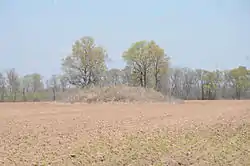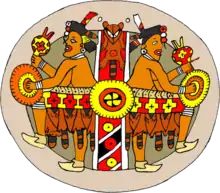Coy Site
The Coy Site (3 LN 20) is an archaeological site located next to Indian-Bakers Bayou in Lonoke County, Arkansas. It was inhabited by peoples of the Plum Bayou culture (650—1050 CE), in a time known as the Late Woodland period. The site was occupied between 700 and 1000 CE. It was listed on the National Register of Historic Places in 1995.
 | |
 Shown within Arkansas | |
| Location | England, Arkansas, Lonoke County, Arkansas, |
|---|---|
| Region | Lonoke County, Arkansas |
| Coordinates | 34°32′56.22″N 91°53′23.64″W |
| History | |
| Founded | 730 CE |
| Abandoned | 1010 CE |
| Cultures | Plum Bayou culture |
| Site notes | |
| Excavation dates | 1883, 1988, 1994 |
| Archaeologists | Edward Palmer |
| Architecture | |
| Architectural styles | platform mounds, burial mound |
| Responsible body: private | |
Description
The site once consisted of four mounds, several flat-topped platform mounds and at least one burial mounds and extensive midden areas. The site was excavated by Edward Palmer in 1883. He described the largest two platform mounds as being 4 metres (13 ft) in height and 3 metres (9.8 ft). He also noted a 2.4 metres (7.9 ft) burial mound and a low mound of undetermined function. Only the largest platform mound survives to the present day. This mound was tested in 1988 and 1994, and returned dates between 730 and 1010 CE.[1]
See also
References
- Rolingson, Martha A. (May 10, 2002). "Plum Bayou Culture of the Arkansas-White River Basin". In Anderson, David G.; Mainfort, Robert C. Jr (eds.). The Woodland Southeast. University of Alabama Press. pp. 46–50. ISBN 978-0817311377. Retrieved 2013-02-20.
| Wikimedia Commons has media related to Coy Mound Site. |

